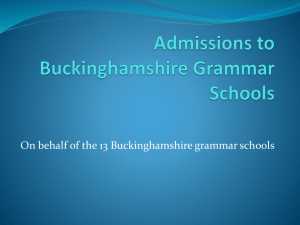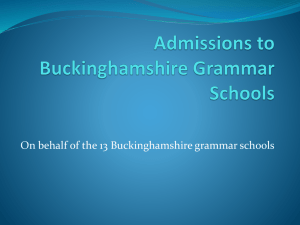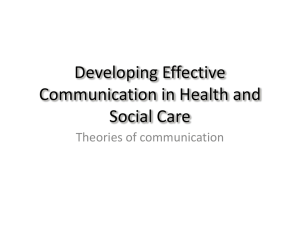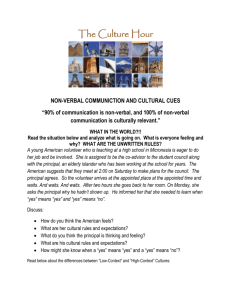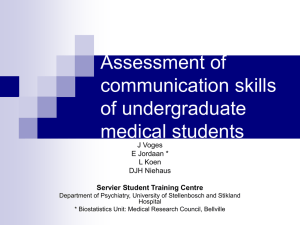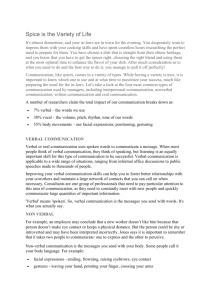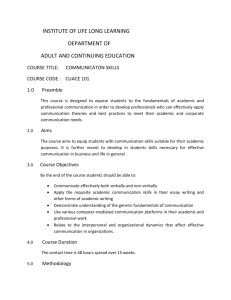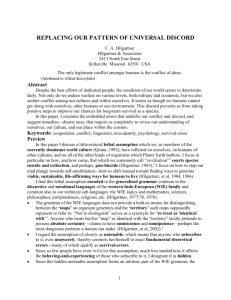CAN WE TRUST OUR LANGUAGE
advertisement
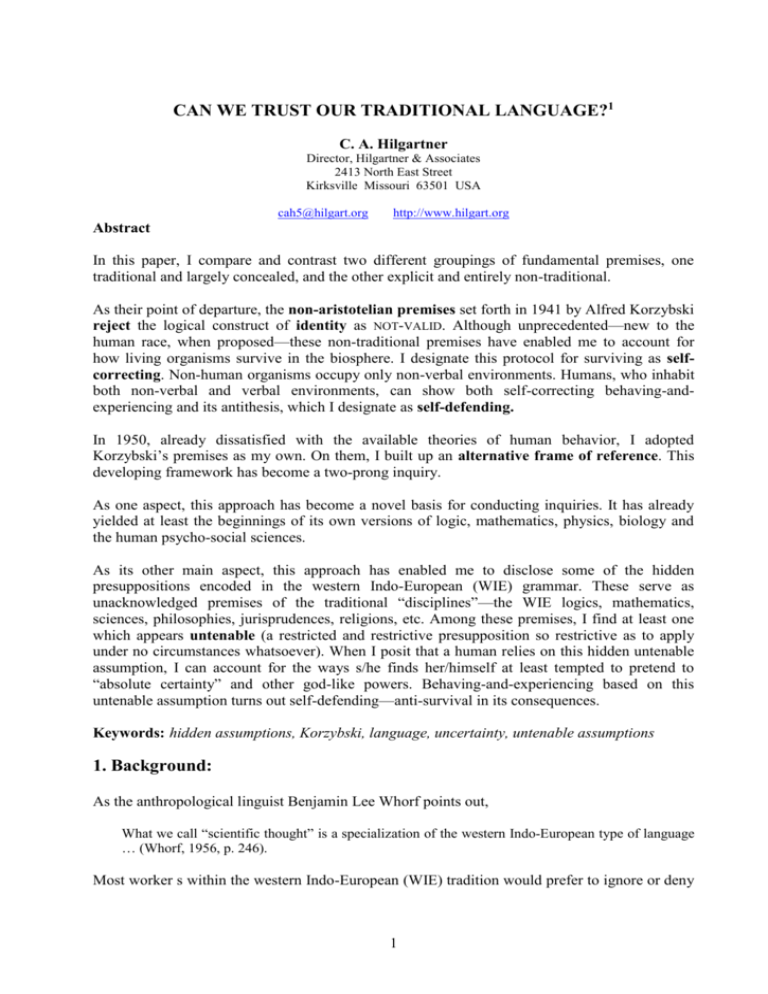
CAN WE TRUST OUR TRADITIONAL LANGUAGE?1 C. A. Hilgartner Director, Hilgartner & Associates 2413 North East Street Kirksville Missouri 63501 USA cah5@hilgart.org http://www.hilgart.org Abstract In this paper, I compare and contrast two different groupings of fundamental premises, one traditional and largely concealed, and the other explicit and entirely non-traditional. As their point of departure, the non-aristotelian premises set forth in 1941 by Alfred Korzybski reject the logical construct of identity as NOT-VALID. Although unprecedented—new to the human race, when proposed—these non-traditional premises have enabled me to account for how living organisms survive in the biosphere. I designate this protocol for surviving as selfcorrecting. Non-human organisms occupy only non-verbal environments. Humans, who inhabit both non-verbal and verbal environments, can show both self-correcting behaving-andexperiencing and its antithesis, which I designate as self-defending. In 1950, already dissatisfied with the available theories of human behavior, I adopted Korzybski’s premises as my own. On them, I built up an alternative frame of reference. This developing framework has become a two-prong inquiry. As one aspect, this approach has become a novel basis for conducting inquiries. It has already yielded at least the beginnings of its own versions of logic, mathematics, physics, biology and the human psycho-social sciences. As its other main aspect, this approach has enabled me to disclose some of the hidden presuppositions encoded in the western Indo-European (WIE) grammar. These serve as unacknowledged premises of the traditional “disciplines”—the WIE logics, mathematics, sciences, philosophies, jurisprudences, religions, etc. Among these premises, I find at least one which appears untenable (a restricted and restrictive presupposition so restrictive as to apply under no circumstances whatsoever). When I posit that a human relies on this hidden untenable assumption, I can account for the ways s/he finds her/himself at least tempted to pretend to “absolute certainty” and other god-like powers. Behaving-and-experiencing based on this untenable assumption turns out self-defending—anti-survival in its consequences. Keywords: hidden assumptions, Korzybski, language, uncertainty, untenable assumptions 1. Background: As the anthropological linguist Benjamin Lee Whorf points out, What we call “scientific thought” is a specialization of the western Indo-European type of language … (Whorf, 1956, p. 246). Most worker s within the western Indo-European (WIE) tradition would prefer to ignore or deny 1 Whorf’s insight. That I cannot do. For my work over the past almost six decades has shown that comment as an accurate, acute observation. As my work progressed, the detailed findings I arrived at turned out to illustrate many of Whorf’s key generalizations. I have conducted a two-prong study. As one main aspect, I have generated an alternative frame of reference, based on consciously-chosen premises, the non-aristotelian premises set forth in 1941 by Alfred Korzybski (1879-1950). By now, it has become a novel basis for doing science—one that rejects the unacknowledged presuppositions encoded in the generalized grammar common to the tongues of the WIE family (or on the grammar of any other traditional language or family of languages). As its other main aspect, this developing approach has provided a standpoint from which I have disclosed some of the unsuspected, unacknowledged assumings encoded in the WIE grammar (Hilgartner, 1977/78, 1978, 2002). These assumings form covert or unnoticed premises of the WIE “disciplines”—the logics, mathematics, sciences, philosophies, jurisprudences, religions, etc., of the WIE tradition (as Whorf suggests in the passage quoted above). Among the premises encoded in the WIE grammar, I find at least one which appears untenable (“a restricted and restrictive assumption so restrictive as to apply under no circumstances whatsoever”). I further discuss this untenable assumption below (section 8.2). 2. The Premises of my Alternative Frame of Reference Korzybski (1941), to consolidate the foundations he laid down in his two books (Korzybski, 1921, 1933), proposed explicit premises (three undefined terms and three postulates). Today these serve as a compact summary of the principles underlying his work. I start from these premises. 2.1. Setting Korzybski did not discuss a context (environment) for his non-aristotelian system as a whole, or for its premises. For my alternative frame of reference, I find it obligatory to posit a setting for the non-aristotelian undefined terms and postulates and for the whole framework. From my alternative viewpoint, these premises presuppose a “dramatic situation” (setting) which I can express in English by run-on phrases such as a-specified-organism-(“he”)-taken-as-awhole-dealing-with-“his”-environment-at-a-date, as viewed by a designated observer (“she”) who operates from the non-aristotelian premises. (Here, I appropriate two of the personal pronouns, he and she in all of their inflectional forms. Discarding any implication of gender, I use these pronouns to indicate logical role in this setting: he, him, etc., to mean “our specified organism” and she, her, etc., to mean “our designated observer”.) 2.2. Korzybski’s Undefined Terms Structure, order, and relations. Korzybski, who wrote mostly in English, used these undefined terms mainly as noun-forms. 2 2.2.1. Hilgartner’s Version When I use a WIE discursive language such as English to express my alternative frame of reference, I prefer to treat these terms as verbs. (to) structure, (to) order, (to) relation. 2.3. Basis for a Non-aristotelian Grammar In order to “say more” about a given, legitimate usage of one of the undefined terms, COMBINE the remaining two undefined terms. Thus, to “say more” about a specific usage S of the undefined term structuring, combine two distinct usages of one of the two remaining undefined terms (e.g. R , usages of relationing), with one usage of O (ordering). The entire expressing would then look like” S R 1 R2 O I use this patterning below, in section 3.5 and Table 1. 2.4. Korzybski’s Version of the Non-aristotelian Postulates Non-identity:The map IS NOT the territory. A word IS NOT the fact, feeling, situation, relation, etc. Non-allness:The map represents NOT ALL the territory. A word covers NOT ALL the characteristics of an object, fact, feeling, etc. Self-reflexiveness:The map is SELF-REFLEXIVE. Language also is self-reflexive in the sense that in language we can speak about language. (Korzybski, 1941) I have abbreviated these postulates by saying that any act of abstracting or any abstraction remains intrinsically ‘inaccurate’, ‘incomplete’ and ‘self-referential’. 3. A Corollary: An Ordering on Abstracting Consider a situation: Someone speaks1. Then someone speaks2-about-that-speaking1. Then someone speaks3-about-this-speaking2-about-that-speaking1. From the Postulate of Self-reflexiveness, I INFER that the speaking2-about-the-speaking1 differs in some fundamental way(s) from the speaking1; and the speaking3-about-the-speaking2 differs from both. To make it easier to test this inference, I propose a way to keep track of such locutions. I propose that, when one or more speakers generate such manifestations of Self-reflexiveness, they thereby generate a series of what I might colloquially call “logical levels” (or in my own technical terms, an ordering on abstracting). By convention, I regard each subsequent “level” in the series that they generate as coming “higher”, by one “level”, than does the previous one. 3 4. Disallowing ‘Map’-‘Territory’ Identity On the setting specified above, for me to adopt the non-aristotelian premises as my own requires that I reject (disallow) the logical construct of identity or identical with (in the sense of “… absolutely the same in all respects as …”) in any guise or form, explicit or tacit. In this I follow Korzybski’s counsel (Korzybski, 1933, pp. 93, 195). This stance, then, rules out the possibility that I or anyone else might generate a ‘map’ identical with the ‘territory’ to which it allegedly refers. To express the degree of success in surviving within the relevant ‘territory’ which a particular ‘map’ confers, I propose that we speak of the degree to which the organism’s ‘map’ satisfies the criteria as similar in structuring to the relevant ‘territory’.2 4.1 Colloquial Substitutes for Terms Such as Identical With Sentences using terms such as identical with or identity (or their polar opposites not-identical with or non-identity) often turn out ponderous if not downright clumsy. I feel a need for less pretentious, or more operational, phrasings. For example, instead of saying “Our organism treats some A as not-identical with some B ,” I might say “Our organism distinguishes between that A and that B.” Conversely, to replace locutions such as “Our organism treats A as identical with B ,” I might say “Our organism fails, or refuses, to distinguish (or discriminate) between that A and that B .” 5. Self-correcting This entire frame of reference facilitates discussing the survival-aspects of the process of abstracting. The term (to) abstract presupposes a living organism generating ‘maps’ of the relevant ‘territory’ (or ‘environment’ or ‘surroundings’). These function as structurings by which he can guide himself towards surviving in that ‘territory’ for at least a few moments more. In general terms, that means our organism obtaining from his environment that which he needs to take in in order to survive this time, and/or avoiding getting damaged or killed. When he uses his survival-oriented ‘maps’ to guide his further “doings” or “choosings”, in effect our specified organism puts them to test. At the outcome of the encounter, he has opportunities to judge his ‘maps’ (a.k.a. ‘survival-guesses’) in terms of how the encounter observably turned out. If his ‘maps’ appear not-disconfirmed by the actual outcome, he can then turn to the next pressing encounter or situation. In some situations, if his ‘maps’ should turn out disconfirmed, he would end up dead on the spot. “I thought I could successfully cross the superhighway on foot during rush-hour, and now I have become a splat!” In other situations, he could end up injured or otherwise damaged, or embarassed, etc. Or he could end up intact, except with his currently dominant survival-need still not satisfied. An organism that recognizes that his survival-guesses have ended up disconfirmed then has at least some opportunities to guess again and try again to get what he needs. 6. Self-defending 4 The notion of self-correcting tells only half the story for humans. Let me use a bit of my own experiencing to illustrate what I mean. Over the years, I have noticed that at times, I ACT as if “I don’t make any guesses—I know how ‘things’ really ‘ARE’!” Not having ‘MADE’ any guesses, I don’t TEST any; I don’t look to see if any guesses got disconfirmed, and don’t discard discredited ones. Instead, I leave an unsuccessful encounter still clinging to the (unacknowledged) assumptions which I held when I entered it. I probably also make excuses: “It’s MY fault!” “It’s YOUR fault!” “It’s ITS fault!” Behaving-and-experiencing according to this pattern BLOCKS self-correcting. By way of contrast to the term self-correcting, I call this pattern self-defending. But please notice what gets ‘defended’: Not the integrity of the organism’s integument or body-parts; not the organism’s ‘feelings’, nor his interpersonal relations. This pattern ‘defends’ only the STARTING-GUESSES. I re-visit the roots of this below, in section 8.2. 7. A Protocol for Surviving-in-the-Biosphere As you have by now seen, I discuss biological survival at the level of individual organisms, and express my key points in the terminology of self-correcting systems. I can summarize what I have said by stating a protocol for survival which each kind organism familiar to me appears to follow: Organisms survive in the biosphere by functioning in a manner analogous to the ways a self-correcting system functions. 8. Human Languaging: Some Generalizations From the perspective of my alternative frame of reference, we need to consider the environment (setting) within which humans language. I contend that every kind of organism familiar to me can, and does, perform nonverbal acts (or to use my technical terms, does engage in non-verbal abstracting)— it performs-within-its-environment with no ‘words’ involved in any way. Non-human organisms, so far as I know, live solely and exclusively within the non-verbal. To the best of my knowing, only humans language (e.g., speak-and-listen, write-andread, sign-and-‘read’-signing, paint-and-view-paintings, etc.). Further, only humans language about our own languaging, our own abstracting. Thus only humans experience, intimately and at first hand, both non-verbal and verbal abstracting. As viewed from my alternative frame of reference, humans structure our languaging in particular, and any kind of symbolizing in general, after the fashion of a postulational system. Or in other words, our methods of ‘communicating’ with ourselves-and-eachother rest upon PRESUPPOSINGS. As our designated observer sees it, the presuppositions encoded in a grammar EXPRESS DISTINCTIONS. Or perhaps, by twisting the usual patternings of English sentences into a more action-oriented phrase, I can put it more precisely: The presupposings encoded in a grammar express DISTINGUISHINGS. Within my alternative frame of reference, I structure the construct of to distinguish as “a grouping of two or more alternative relationings, each one of which consists of at least two orderings. Of these, at least one ordering I regard as non-verbal, and at least one as verbal.” (See section 2.3. Basis for a Non-aristotelian Grammar) 5 Consider an example from the archeology or paleontology of early humans. Strata deposited before some specific date or era contain no shaped stone artifacts. Strata deposited after that date or era do include pieces of silica-rich rock—flint, quartz, obsidian, etc.—which, when stressed, develop conchoidal fractures, which may include sharp edges, and which workers regard as shaped-stone “tools” or “weapons”. I infer that the humans who lived before the date or era I mentioned saw, or classified, those non-verbal “doings” or “happenings” in their environments that we might call (non-verbal) “rocks” as ALL ALIKE, in some key sense. I further infer that the humans who lived after that date or era (non-verbally) distinguished what we call (non-verbal) “rocks” into at least two (nonverbal) kinds, one of which DOES develop (non-verbal) sharp edges when skillfully fractured, and the other of which DOES NOT. Furthermore, I surmise, they generated VERBAL CONSTRUCTS to “indicate” or “name” these two non-verbal kinds. TABLE 1 DISTINGUISHING Ordering1 (Verbal, “signifier”) Ordering2 (Non-verbal, “signified”) Relationing1 a. Spoken/written LABELS for the non-verbal (e.g., “Flint”) a. Actual samples of rock that develop conchoidal fracture (flint, quartz, obsidian, etc.) Relationing2 b. Spoken/written LABELS for the non-verbal (e.g., “Limestone”) b. Actual samples of rock that do not develop conchoidal fracture (limestone, sandstone, shale, etc. Legend: As our designated observer sees it, our specified organism structures a particular distinguishing (which he expresses as relationing1,2,etc.) by framing for each relationing a verbal ‘indicator’ (ordering1a,b), which points at non-verbal “doings” or “happenings” (ordering2a,b) distinctly different from those pointed at by the other ‘indicator(s)’. In a WIE language (such as English, or the mathematical theory of sets) we have at least two ways of indicating “a distinguishing or discriminating”. We can indicate a distinguishing: o by “form” (such as some grammatical marker—e.g. a prefix, infix, or suffix, or a specialized vocabulary, etc.). Examples: The discursive distinction known as number: E.g., Singular: cat; Plural: cats. Set theory cognate of the discursive construct of number: a single variable x ; a collection of variables xi (where i = 1, 2, 3, …). When the grammar does not contain “forms” by which to indicate this particular distinguishing, languagers can still distinguish between the various alternatives: o by “content” (as in the jest, “The next time you visit a restaurant, please make sure that you eat the meal (non-verbal ‘territory’ or Thing Named), and not the menu 6 (verbal ‘map’ or Name).”) 8.1. To Distinguish or Not To Distinguish Please consider a distinguishing which our designated observer regards as a survival-issue. Imagine a tongue in two versions. In one, its grammar DOES include grammatical forms that require languagers to make that crucial distinction; in the other version, its grammar DOES NOT include such forms. 8.1.1 Where the grammar DOES include the relevant forms, languagers find making the distinction mandatory. Every person who becomes sufficiently fluent in this tongue learns the forms by which to make that key distinction, and learns how and when to use them in an acceptable way. Further, s/he gets ample practice in MAKING the distinction, for s/he must use the relevant forms in every instance in which the topic arises. As long as non-verbal “doings” or “happenings” for the forms to “refer to” do occur—as long as the ‘maps’ generated by using the forms do confer some predictability—then those who language in this tongue will come to regard the distinction made by using these forms as indicating “a feature of the world we live in”. They treat this distinguishing as part of their symbolic environment. 8.1.2 Where the grammar DOES NOT include any forms to indicate this key distinguishing, every person who becomes fluent in this tongue learns, at the very least, to regard that distinguishing as not important, not mandatory. At worst, s/he learns NOT TO MAKE THAT DISTINCTION AT ALL. S/He seems unlikely to regard that topic, that distinguishing, as a significant feature of her/his symbolic environment. However, any languager can make the distinction at the level of “content” (as noted above). Doing so depends on individual insight, purpose, and even just remembering to use the relevant terms from the general vocabulary. If the speaker should omit making the distinction, few listeners would notice the omission. 8.2. Some Presuppositions Encoded in the WIE Grammar As I point out above, humans intimately experience, at first hand, both the non-verbal (‘territory’) and the verbal (‘map’). However, the generalized grammar common to the languages of the WIE family provides no forms, specialized vocabulary, or other way(s) to distinguish between non-verbal and verbal abstracting. Operationally speaking, the WIE grammar provides no way to say or indicate, “Here I use noun1 to point to the relevant nonverbal “doings” or “happenings”, and there I use noun1 to point to the verbal construct.” From the standpoint of my alternative frame of reference, this looks like a severe DISSONANCE— the structuring of the (verbal) generalized grammar common to the WIE family of languages appears DISSIMILAR to the intimate structuring of the (non-verbal) behaving-and-experiencing of humans. It corresponds to the case described in section 8.1.2 above. By failing to include or encode any way to distinguish between non-verbal and verbal abstracting, the grammar of languages of the WIE family (Danish, English, French, Hindi, Sanskrit, etc.) eliminates this (verbal) distinction/distinguishing from consideration. 7 Let me frame that dissonance, that eliminating from consideration, as “our specified (human) organism under observation PRESUPPOSING”. For this human, as an unwary WIE languager, the topic of (verbally) distinguishing between non-verbal and verbal abstracting does not arise. Or in other words, he non-verbally ACTS as if he had no occasion or need so to distinguish verbally. But that amounts to TACITLY ASSUMING that non-verbal abstracting and verbal abstracting satisfy the criterion of “absolutely the same in all respects”. I designate such assuming as tacit identity. Here, it would mean tacitly assuming that Generic terms: verbal non-verbal Specialized term-pairs Name Thing Named symbol referent ‘map’ ‘territory’ etc. On the setting I specified above, in order for our designated observer to distinguish (verbally) between non-verbal and verbal, she must posit a (verbal) “speaker” or “languager” (organism dealing with his environment or ‘territory’) who abstracts both non-verbally and verbally, so as to generate both non-verbal and verbal abstractions (‘maps’), which occupy different positionings in an ordering on abstracting (different “logical levels”). The five terms which I put in boldface type amount to a circle of mutually inter-dependent constructs. When our specified human organism DOES NOT DISTINGUISH between non-verbal and verbal— when he ASSUMES tacit identity and ACTS on that assuming—in effect he eliminates from consideration not only the (verbal) constructs of non-verbal and verbal, but also (verbal) designated observer, specified organism (languager or ‘map’-maker), the process of abstracting, any abstractions (products of abstracting), and any ordering on abstracting (“logical levels”). Or, more succinctly stated, he eliminates from consideration the (verbal) construct of the observer, taken in every sense that I know of. With these constructs eliminated from consideration, he has no resources by which to claim (explicitly and verbally) to have a definite, limited point of view, that of a limited speaker or agent—instead, as he generates locutions that do not even mention an agent, he engages in the pretense that what he says “comes from the mouth of God”. This ‘objective’ mode of speaking, by eliminating mention of the agent, leaves him apparently unknown in his omniscience and unmoved in his omnipotence. At least as far back as the Sanskrit sacred writings, WIE languagers have agonized over the distinction between the living and the non-living—how to tell what lives (and how it does so) and what does not. Their presuppositions yield a dualism (e.g., an unbridgeable gap with ‘matter’ on one side and ‘mind’ or ‘spirit’ or ‘soul’ on the other). Then they could ‘explain’ ‘life’ only by positing something that could bridge that unbridgeable gap—magic, or the intervention of a god—which/who “animates” the non-living ‘matter’ of the ‘body’ of the ‘organism’—for a while. They explained ‘death’ by positing that the animating ‘spirit’ has departed, leaving behind only the non-living ‘matter’ of the ‘body.’ Any languager who relies on the assumption of tacit identity treats-and-regards that dualism as OBVIOUS FACT, as if it ‘existed’ in the (supposed) ‘external world’. 8 Such presupposing of tacit identity entails what our designated observer regards as disadvantages—mere pretenses, such as the delusions that our organism can attain ‘objectivity’ (freedom from self-reference); can have no presuppositions that he could in principle test (and revise, or reject and replace); that he has no point-of-view (but instead “speaks with the mouth of God”); etc. Indeed these presuppositions enshrine ‘objectivity’ as the desideratum of science in particular and of scholarly work in general, and debase ‘subjectivity’ (having a personal viewpoint, with self-reference) as the criterion of unreliability. 9. Discussion In the process of drawing these comparisons between the presupposings that underlie my alternative frame of reference and those underlying traditional WIE viewpoints, I came to see that Korzybski’s non-aristotelian premises propose at least three distinctions on the topic of nonverbal vs. verbal, each absent from the grammar of WIE languages. According to the setting for my alternative frame of reference, our specified human organism “deals with” his environment (‘territory’)—engages in abstracting—and generates a product of abstracting, an abstraction (‘map’). Non-identity proposes that we systematically distinguish between verbal and nonverbal (or, between Name and Thing Named, or symbol and referent, or ‘map’ and ‘territory’, etc.). Non-allness assumes that our specified human can at least TALK ABOUT the verbal as opposed to the non-verbal. This postulate then tacitly specifies the possible relationings between the verbal and the non-verbal, in one-to-many terms: The “one” consists of “an exhaustively complete, entirely accurate relationing between the verbal and the non-verbal”; the “many” term designates the multifarious ways in which the relationing between the verbal and the non-verbal conceivably could appear as not-exhaustive, not-entirely-accurate. Given this distinction, the Postulate of Non-allness RULES OUT the “one”, the exhaustive and accurate (a.k.a. identity) instance, in favor of the “many”. Self-reflexiveness proposes that any act of abstracting, any abstraction, contains an internal distinction—each includes both a component that refers to ‘other’, the organism’s environment, and one that refers to ‘self’, the organism (‘map’-maker) himself. I maintain that these three distinctions, taken together, yield an assumed (symbolic) Cosmos or Universe which (symbolically) harbors (symbolic) living organisms, including (symbolic) humans. Further, these organisms (symbolically) live under conditions of radical uncertainty. In contrast, when someone accepts identity as valid, s/he thereby eliminates uncertainty and eliminates these distinctions from consideration. S/He thereby obtains an assumed (symbolic) Cosmos or Universe void of (symbolic) living organisms—composed solely and exclusively of (symbolic) non-living matter. My alternative frame of reference delivers a formal criterion for making the distinction between living and non-living.(Hilgartner, 1976; Hilgartner, et al., 2004) As a central feature, this criterion requires the construct of “logical levels” (or an ordering on abstracting). In my view, anyone who eliminates the distinction between non-verbal and verbal thereby makes it impossible to represent the distinction between living and non-living. 9 To date, outside of my alternative frame of reference, no one else that I know of has structured the topic of distinctions (or distinguishings) in a fashion similar to what I present here. Furthermore, from Korzybski’s premises, I have derived a “grammar”, and on it have built up a “Let’s Keep Track of What We Say” notation. (Hilgartner, 1977/78, 1978, 2002) This notation makes these distinctions at the level of “form”. No one else that I know of has provided a derived “grammar” and a notation that makes these distinctions at the level of “form”. Our designated observer long ago assimilated these distinguishings and some of what they imply. In contrast to the disadvantages that follow from using the traditional assumings encoded in the WIE grammar, the results of using these non-traditional distinguishings look like advantages. Korzybski’s premises require that anyone who uses this alternative frame of reference must acknowledge holding as her/his own the underlying presuppositions, and acknowledge having and using a point of view based on them. S/He has what it takes to reject the pretense to ‘objectivity’, and with it, the pretense to “absolute certainty” and other god-like powers, and even the deity-like tone of discourse. S/He must assent to, and assimilate, the at least three distinct usages of the construct of the observer intrinsic to this alternative frame of reference. To summarize, since humans deal at first-hand with both non-verbal and verbal abstracting, but the presupposings encoded in the grammar of the WIE languages eliminate the ability to deal with this distinction, I infer that the ‘maps’ generated by people relying on that grammar satisfy the criteria as similar in structuring to no (symbolic) ‘territory’ that harbors (symbolic) living organisms, including humans. In previous papers, I have discussed some more of the consequences of the usage of tacit identity encoded in the grammar of the WIE languages, as contrasted with the consequences of rejecting that usage of tacit identity.(Hilgartner, et al., 2002b; Hilgartner, 2003; Hilgartner, et al., 2004) 10. Conclusions Languages that accept the logical construct of identity (tacit or explicit) as valid appear unbearably dangerous. They encourage users to pretend to certainty, and to succumb to the temptation to claim god-like powers. They do not and cannot guide us, or anyone else, toward long-term survival. Nor may humans safely rely on them to analyze or evaluate solutions to our survival problems! They can point us the way only to a (non-verbal) Cosmos or Universe void of (non-verbal) living organisms—one composed solely and exclusively of (non-verbal) non-living matter. In contrast, my alternative frame of reference, which rejects (disallows) the logical construct of identity, appears capable of supporting us humans to generate viable, sustainable, life-affirming ways for humans to live. References Hilgartner, C.A. (1976). “A Rigorous Criterion for Living.” Unpublished ms. Hilgartner, C. A. (1977/78). “Some Traditional Assumings Underlying Western Indo-European Languages: Unstated, Unexamined, and Untenable.” General Semantics Bulletin Nos. 44/45, pp. 132-154. 10 Hilgartner, C. A. (1978). “The Method in the Madness of Western Man”. Communication 3:143242. Hilgartner, C. A. (2002) “A Strictly Dynamic Notational Language For Science”. International Journal of Computing Anticipatory Systems 11:43-58. Hilgartner, C. A., Weld S. Carter, Jr., & Martha A. Bartter (2002a). Languaging for Survival. Advances in Sociocybernetics and Human Development 10:21-34. Hilgartner, C. A., Weld S. Carter, Jr., & Martha A. Bartter (2002b). “Languaging for Survival”. (Version presented.). Invited Keynote Address, presented at the 14th International Conference on Systems Research, Informatics & Cybernetics, Baden-Baden, Germany, 29 July-3 August 2002. Hilgartner, C. A. (2003). Replacing Our Pattern of Universal Discord. Invited Keynote Address, presented at the 15th International Conference on Systems Research, Informatics & Cybernetics, Baden-Baden, Germany, 28 July-2 August 2003. Sociocybernetics and Human Development 11:53-66. Hilgartner, C. A., Weld S. Carter, Jr., & Martha A. Bartter (2004). What Biologists Should Know, But Don’t. Presented at the 16th International Conference on Systems Research, Informatics & Cybernetics, Baden-Baden, Germany, 3 August 2004. In press, Advances in Sociocybernetics and Human Development. Korzybski, Alfred (1921) Manhood of Humanity: The Science and Art of Human Engineering. New York: E. P. Dutton, 1921. 2nd Ed., (1950), M. Kendig (ed.), Institute of General Semantics, Lakeville CT 06030. Korzybski, Alfred (1933). Science and Sanity: An Introduction to Non-aristotelian Systems and General Semantics. Non-Aristotelian Library Publishing Co., Chicago. Institute of General Semantics, Lakeville CT 06030, distributors. 4th edition, 1958. 5th edition, 1994 Korzybski, Alfred (1941). General semantics, psychiatry, psychotherapy, and prevention. American Journal of Psychiatry 98(2):203-214 (1941). Revised version, M. Kendig (ed.), Papers from the Second American Congress on General Semantics. Chicago: Institute of General Semantics, pp. 93-108. (1943). Reprinted in M. Kendig (ed.), Alfred Korzybski Collected Writings 1920-1950. International Non-Aristotelian Library, Institute of General Semantics, Englewood, NJ, 1990, pp. 295-308. 1 This paper forms an introduction to a longer paper which I had hoped to make available for distribution to the present audience. The longer paper would have additional applicable keywords: Ashby, Hoppenbrouwers, linguistics. I welcome requests for that paper, which I will fill when I have completed it. 2 Operational ‘meaning’ of a ‘map’ similar in structuring to the ‘territory’: I derived a testable hypothesis from the ‘map’, and put it to test. It ended up NOT-DISCONFIRMED. So I infer that that ‘map’ appears to some degree similar in structuring to the relevant ‘territory’. 11
